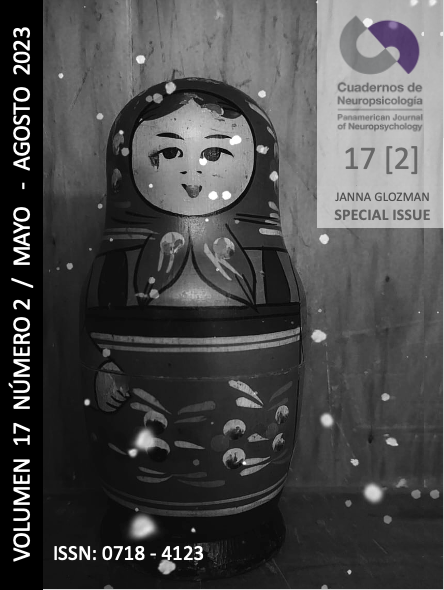Lurian neuropsychological syndromes
Abstract
ABSTRACT
This article summarizes A. R. Luria's contributions to psychology and neuropsychology: we identify and explain his five essential concepts related to the neuropsychological syndromes (higher mental functions, functional system, neuropsychological factor, symptom and syndrome) and the neurological syndromes themselves, as well as characteristics that we can observe in clients as we go through each part of the Lurian neuropsychological assessment: Pre-Motor Syndrome (post-frontal - Kinetic Syndrome), Prefrontal Syndrome (Regulatory-Executive Syndrome), Mediobasal frontal syndrome (Neurodynamic Syndrome), Occipital or occipital-parietal syndrome (visual and spatial recognition disorder), Parietal Syndrome (kinesthetic and somatic-gnostic disorder), Temporal Syndrome (Acoustic and Phonemic Perception Disorder and Memory Disorder), TPO Syndrome (temporo-parieto-occipital), Memory Syndrome, Interhemispheric Interaction Disorder Syndrome or Corpus Colossus Syndrome and Language Syndrome. Rehabilitation is not to be done considering just one brain function at a time, but all of them together as a whole. According to J. M. Glozman, this is the practical value of A. R. Luria's entire syndromic analysis.
Keywords: A. R. Luria, neuropsychological assessment, neuropsychology, syndrome, symptom, concepts.
RESUMEN
Este artÃculo resume las contribuciones de A. R. Luria a la psicologÃa y la neuropsicologÃa. Identificamos y explicamos: sus cinco conceptos esenciales relacionados con los sÃndromes neuropsicológicos (funciones mentales superiores, sistema funcional, factor neuropsicológico, sÃntoma y sÃndrome) y los sÃndromes neurológicos en sÃ, asà como las caracterÃsticas que podemos observar en los clientes de cada uno de ellos. parte de la evaluación neuropsicológica de Luriana (SÃndrome Premotor (Postfrontal - SÃndrome Cinético), SÃndrome Prefrontal (SÃndrome Regulador-Ejecutivo), SÃndrome Frontal Mediobasal (SÃndrome Neurodinámico), SÃndrome Occipital u Occipital-Parietal (Trastorno del Reconocimiento Visual y Espacial), SÃndrome Parietal (trastorno cinestésico y somático-gnóstico), SÃndrome Temporal (trastorno de percepción acústica y fonémica y trastorno de la memoria), SÃndrome TPO (temporo-parieto-occipital), SÃndrome de Memoria, SÃndrome de Trastorno de Interacción Interhemisférica-SÃndrome del Cuerpo Calloso y SÃndrome de Lenguaje. La rehabilitación no debe hacerse considerando sólo una función cerebral a la vez, sino considerándolas todas juntas como un sistema. Según J. M. Glozman, éste es el valor práctico del análisis sindrómico completo de A. R. Luria.
Palabras Clave: A. R. Luria, evaluación neuropsicológica, neuropsicologÃa, sÃndrome, sÃntoma, conceptos.
Â
RESUMO
Este artigo resume as contribuições de A. R. Luria para a psicologia e a neuropsicologia. Identificamos e explicamos: seus cinco conceitos essenciais relacionados à s sÃndromes neuropsicológicas (funções mentais superiores, sistema funcional, fator neuropsicológico, sintoma e sÃndrome) e as próprias sÃndromes neurológicas, bem como caracterÃsticas que podemos observar nos clientes em cada parte da avaliação neuropsicológica Luriana (SÃndrome Pré-Motora ou pós-frontal - SÃndrome Cinética), SÃndrome Pré-Frontal (SÃndrome Regulatória-Executiva), SÃndrome Frontal Mediobasal (SÃndrome Neurodinâmica), SÃndrome Occipital ou Occipital-parietal (transtorno de reconhecimento visual e espacial), SÃndrome Parietal (transtorno cinestésico e somático-gnóstico), SÃndrome Temporal (transtorno de percepção acústica e fonêmica e transtorno de memória), SÃndrome TPO (temporo-parieto-occipital), SÃndrome de Memória, SÃndrome de Transtorno de Interação Inter-hemisférica ou SÃndrome do Corpo Caloso e SÃndrome da Linguagem. A reabilitação não deve ser feita considerando apenas uma função cerebral de cada vez, mas considerando todas juntas como um sistema. De acordo com J. M. Glozman, este é o valor prático da análise sindrômica completa de A. R. Luria.
Palavras-chave: A. R. Luria, avaliação neuropsicológica, neuropsicologia, sÃndrome, sintoma, conceitos.
Downloads
How to Cite
Issue
Section
License
Articles published in this journal are protected under the Creative Commons Attribution-NonCommercial-ShareAlike 4.0 International (CC BY-NC-SA 4.0) license. This means that authors retain full rights over their research and publications at all times. As a journal, we fully respect and promote the principles of open access established by this license, allowing the work to be shared, adapted, and distributed for non-commercial purposes, provided that appropriate credit is given to the authors and any derivative works are licensed under the same terms.
Authors are responsible for obtaining the required permission when they wish to reproduce part of the material (figures, etc.) from other publications.
Likewise, CNPs allows authors to host in their personal sites or other repositories that they deem convenient the Final and Definitive Version of the published article with the format assigned by the journal. In no case do we allow access to preprints of the article under evaluation or already published.
When submitting an article to CNPs you are aware that all the contents of CNPs are under a Creative Commons License. In which it is allowed to copy and share the contents freely, always making reference to the origin of the publication and its author.





